One of the best places to go hiking in Japan is on the Kumano Kodo Trail. Quite literally, off the beaten path, this destination is a historic pilgrimage trail that has been trekked for thousands of years. Hiking the Kumano Kodo was a highlight of our time in Japan, and this guide will show you how you can do it too!
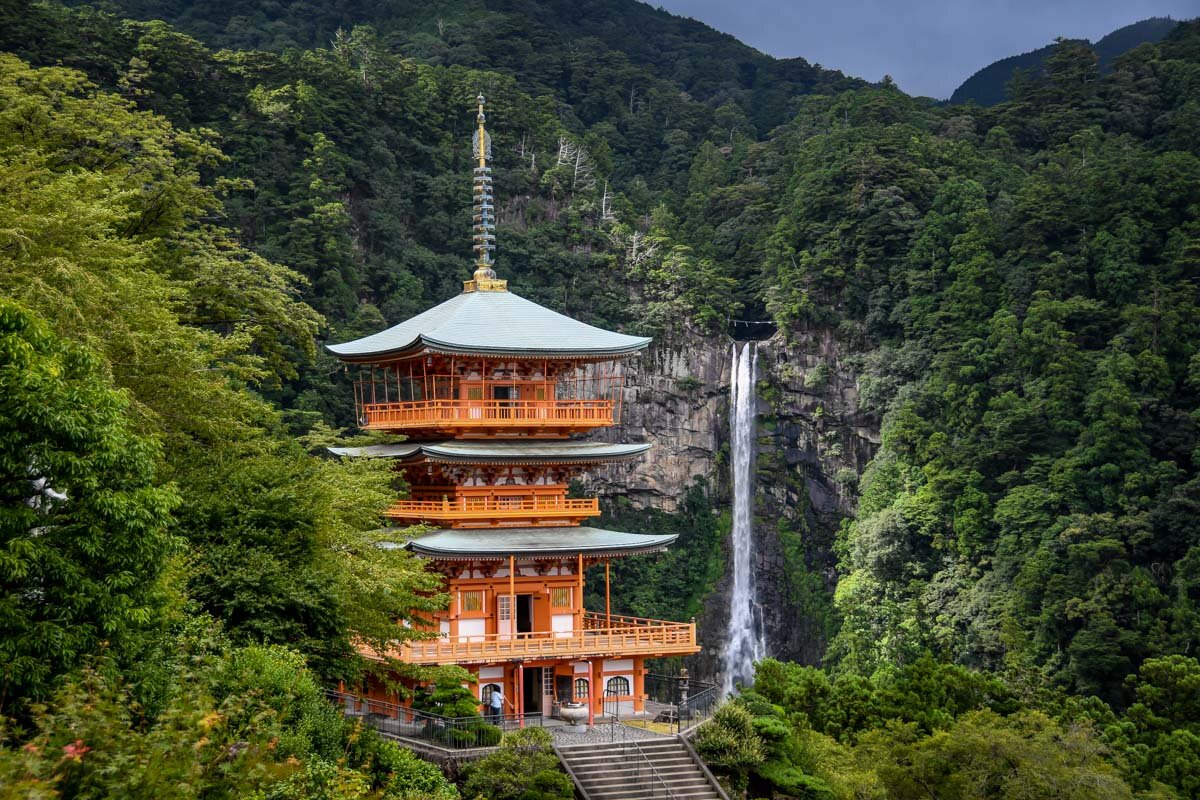
If you are looking to have an authentic and experience in Japan’s countryside and get, quite literally, off the beaten path, you’ll want to keep reading… We’re about to introduce you to the Kumano Kodo Trail, an adventure you’ll definitely want to pencil into your Japan itinerary.
First things first, you might be asking…
What exactly is the Kumano Kodo trail?
The Kumano Kodo is a pilgrimage trail through the mountainous Kii Peninsula, and brings hikers to small villages, past picturesque farmsteads, historic shrines, and through giant cedar forests. It is utterly enchanting and packed with plenty of photo ops as well as views that simply can’t be captured in pixels.
We think hiking the Kumano Kodo Trail is one of the most underrated things to do in Japan, and gives hikers a glimpse into local life and an opportunity to support the people and businesses in this under-visited region.
So if escaping the crowds and being surrounded by nature sounds dreamy, this article has everything you need to plan your Kumano Kodo hike.
We’re going over the history of this iconic walk, where to stay along the way, what to pack, and what to expect along the way. And yes, we’ll tell just how difficult this hike in Japan is so you can plan and prepare accordingly.
Alright, let’s get into it!
Kumano Kodo Trail Guide
- Who is the Kumano Kodo trail for?
- What is the Kumano Kodo?
- What to expect hiking the Kumano Kodo
- When is the best time to hike the Kumano Kodo?
- Kumano Kodo routes
- 3-Day Kumano Kodo trekking itinerary
- Highlights along the Kumano Kodo trail
- How to book accommodation on the Kumano Kodo
- Food on the Kumano Kodo
- What to pack for hiking the Kumano Kodo trail
- Travel tips for the Kumano Kodo
- How much does it cost to hike the Kumano Kodo?
- How to get to the Kumano Kodo
- Kumano Kodo FAQ’s
Come along on the trail with us and watch our Kumano Kodo video:
Who is the Kumano Kodo trail for?

I can’t overstate how highly we would recommend adding this experience to your trip to Japan, but only if you answer “yes” to all of the statements below:
The Kumano Kodo Trail is for you if…
- You want an authentic experience in the Japanese countryside
- You love being in nature
- You like hiking (and don’t mind a few steep stretches)
- You want to escape the crowds
- You want to have a unique experience in Japan that most tourists miss
- You have a sense of adventure
What is the Kumano Kodo?

Let’s begin with a brief history lesson…
Located nearly 100 kilometers (62 miles) south of Osaka on Japan’s Kii Peninsula, the Kumano Kodo is a network of pilgrimage routes that have been in use for more than 1,000 years.
Those who hike the Kumano Kodo will follow in the footsteps of ancient emperors and samurai who made this journey in centuries past. These routes were sacred and held great spiritual meaning since they connected the three famed Kumano shrines:
- Kumano Hongu Taisha
- Kumano Hayatama Taisha
- Kumano Nachi Taisha
In 2004, the Kumano Kodo was named a UNESCO World Heritage Site, and it is one of only two pilgrimage paths to receive this coveted title (the other being Spain’s Camino de Santiago).

Today, the Kii Peninsula is connected by Japan Rail lines. Most routes start from Kii-Tanabe Station, so if you have the JR Pass you can travel to the peninsula for free! Saving you over $100 USD for a round trip from Osaka. The only transportation you’ll have to pay for after that are the buses into the mountains.
Learn how to purchase the JR Pass which gives you unlimited access to Japan’s bullet trains for 7, 14, or 21 days!
What to expect hiking the Kumano Kodo
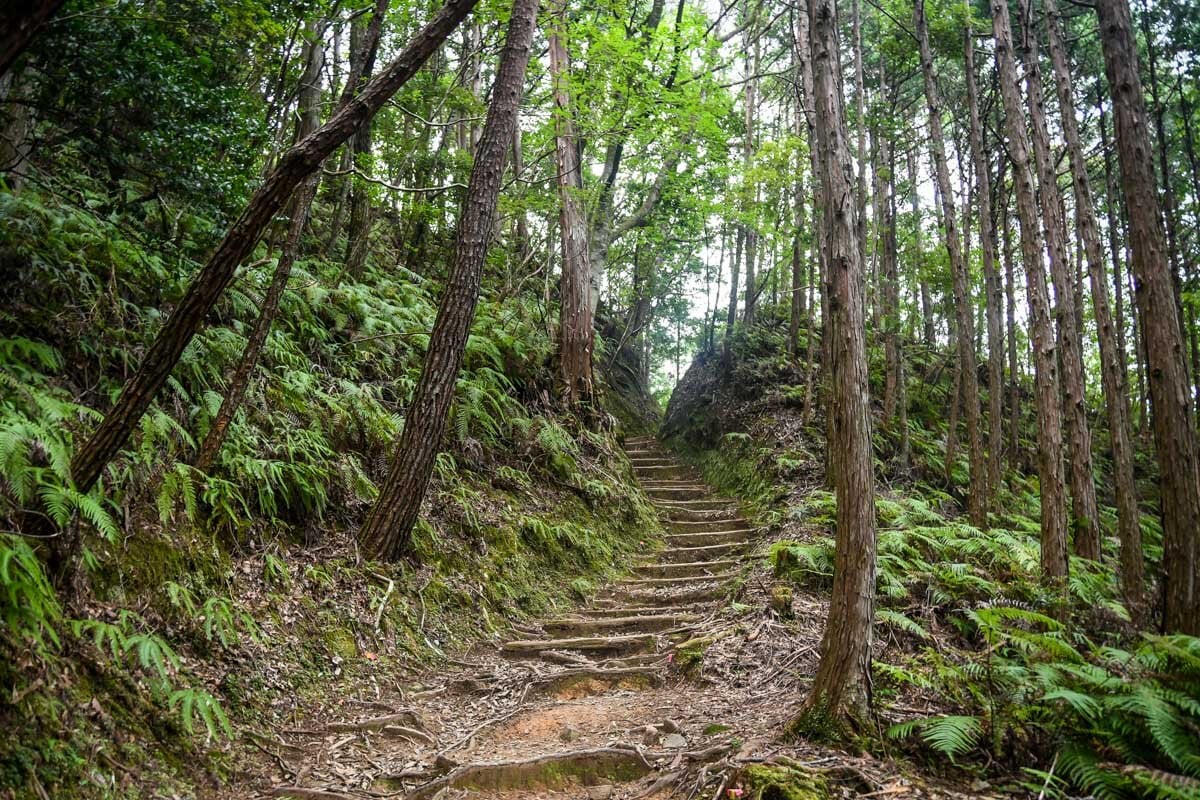
After returning from our 3-week trip to Japan, we were reflecting on our favorite experiences, and we both wholeheartedly agreed that hiking the Kumano Kodo was the most unique and memorable thing we did (and we did a lot!).
So what should you expect exactly?
The paths on the Kumano Kodo are well-maintained and are clearly marked with signs in Japanese and English.
Every half kilometer, there are trail markers signaling where you are on the trail. (They even let you know when you’re veering off the right path, with “NOT Kumano Kodo” in bold letters!). You can use these trail markers along with the maps to show where you are on the route.

These trails weave their way through this mountainous region and take hikers through forests of towering cedar trees, and past oji, or small shrines, meant to protect pilgrims.
You’ll walk past farmsteads and small villages that appear not to have changed in decades. Stand at lookout vistas and see wispy clouds hanging low in the valley over a sea of trees that seem to expand to the horizon.

Along the trail, there are signs marking historical spots, like where inns used to sit as refuge for weary pilgrims. There are small shelters every so often that you can take a rest and have lunch.
Stay at small family-operated inns, eat meals that have been prepared with local ingredients, and soak in hot springs that are common in this region. Visit shrines that have seen thousands of years of travelers hiking passed them.
→ Psst! Check out our list of the most beautiful places in Japan you’ll have to see to believe!
When is the best time to hike the Kumano Kodo?

The good news is that the Kumano Kodo can be hiked all year round.
Wakayama prefecture on Japan’s Kii Peninsula sits pretty far south, meaning the weather in this region tends to be quite mild. To give you a point of reference, Wakayama prefecture is south of Osaka.
Hot tip! Be sure to read up on all the fun things to do in Osaka because you’ll likely be in this city before or after your hike and will want ideas of ways to unwind (or if you’re like us, you’ll want to know exactly where and what to eat!).
Spring and fall are going to offer the most comfortable temperatures as well as beautiful blossoms and fall foliage. That said, these are the most popular times of the year to make the hike, so you’ll encounter more people along the trail.
- Spring: Cherry blossoms and comfortable temperatures make springtime a lovely (and popular!) time to make this hike!
- Summer: The summer months can get very hot and humid, meaning the hike can be uncomfortable at times. Rain is also highly likely, at least for part of your trek, so be prepared. The good thing is that it will be very green at this time!
- Fall: Comfortable temperatures and stunning fall foliage make this a very nice time to hike, and for this reason, it is a popular season on the Kumano Kodo.
- Winter: While temperatures can get cold and snow is possible, the Kii Mountains tend to be more temperate than other mountain ranges in Japan. There will be fewer people hiking in Japan in the winter than at other times of the year.
No matter what time of year you plan to hike, be prepared for rain, as the weather in the mountains can change quickly and can be quite different from the weather in surrounding cities.
Our advice is to read up on the best time of year to travel to Japan and decide what season sounds best to you based on your preferences.
Good to know: August and September are peak typhoon months, and transportation may be affected in the case of inclement weather. Also, portions of the trail may be affected by landslides caused by heavy rains. Be sure to get trail updates from the information centers before you head out.
Our opinion: We hiked the Kumano Kodo in August, and we experienced high humidity and a bit of rain (see our full experience with the weather below). That said, we hardly encountered other hikers, and we were prepared for the not-so-wonderful hiking weather, so we had a good time. We kept saying that if we were to do it again (and we really want to!), we’d choose to hike in the fall.
Our experience with the weather on the Kumano Kodo

We hiked the Kumano Kodo during the month of August, and we experienced the heat and humidity we had read about online.
We were pretty nervous about the weather and even considered not doing the hike at all. However, we still had a great – no, incredible – time. We were prepared for the heat and humidity, and actually it wasn’t quite as bad as we were expecting. The mountain air, while still muggy, felt considerably fresher than the stifling August heat in Osaka.
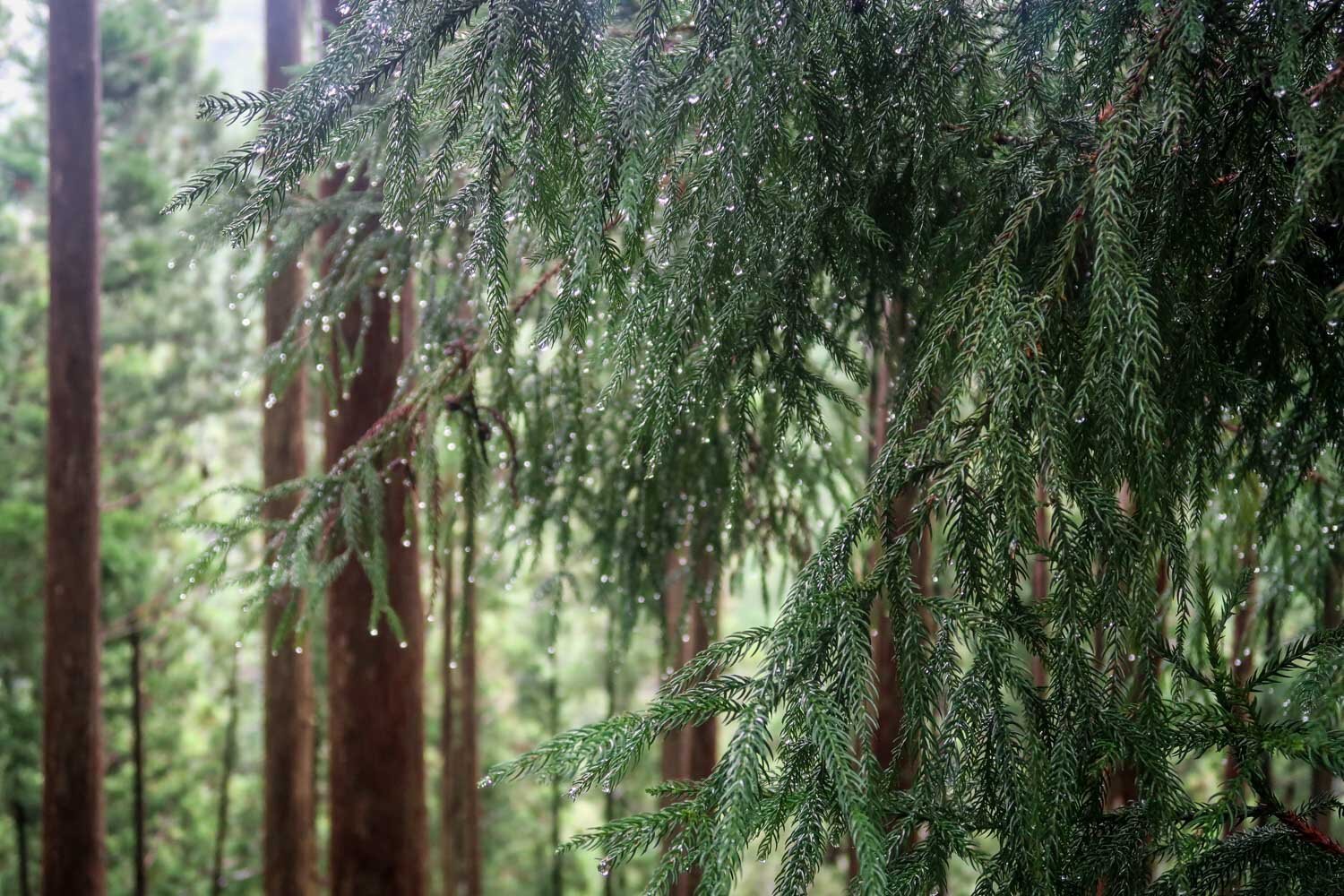
We also had quite a bit of rain – on and off for one day, and very heavy rain on another day. But in between, we also had beautiful, clear skies, so it was a bit of a mixed bag. We had a dry bag to keep our electronics in, raincoats to keep ourselves dry, and , so we didn’t mind the rain all that much. It actually cooled us down, and thankfully stopped at most of the scenic places we visited.
Kumano Kodo routes
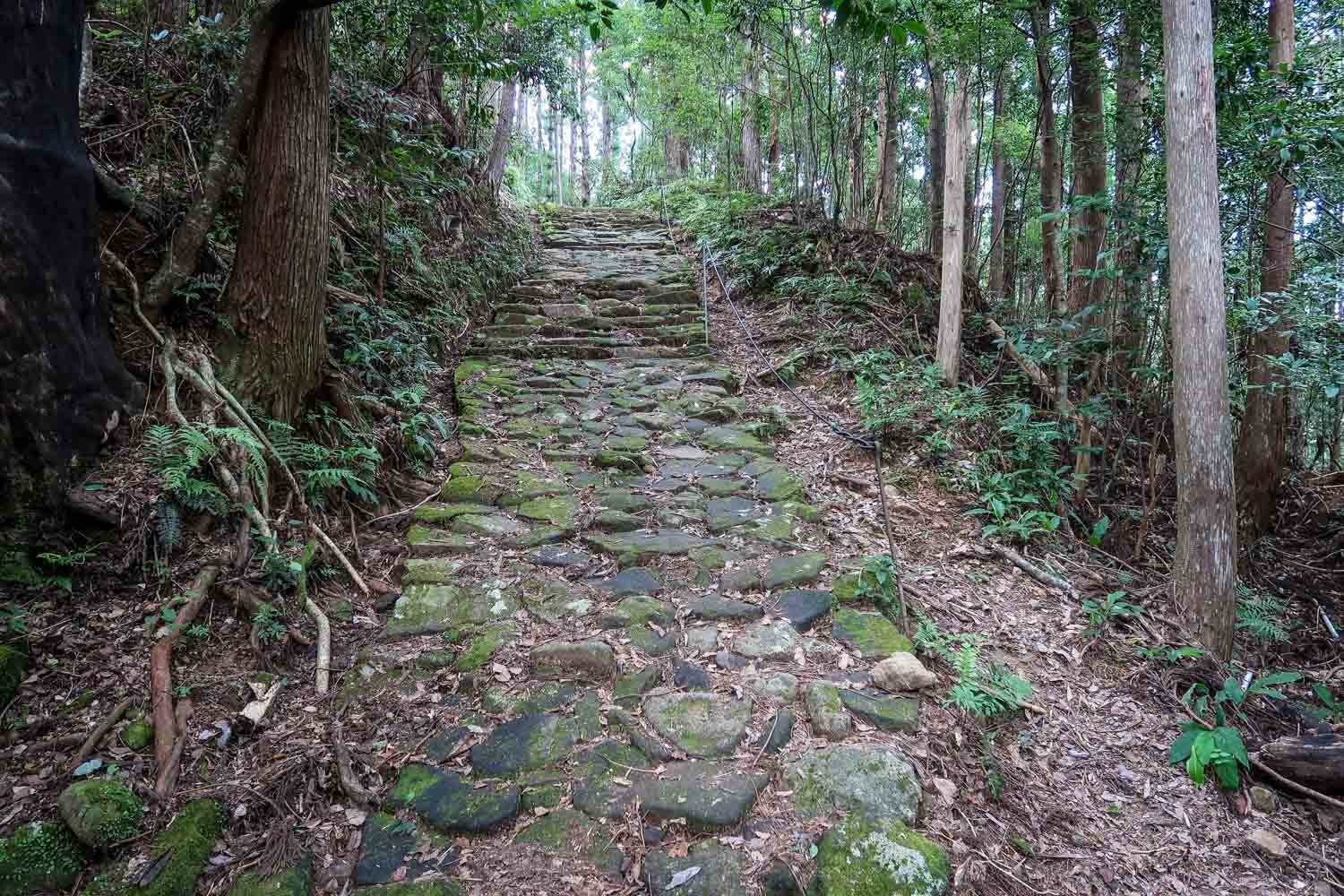
The Kumano Kodo is a network of trails, so most people will choose just one route. Additionally, it’s easy to do just a section of the trail, enabling many hikers (ourselves included) to do just a portion of the trail in order to fit it into their Japan trip.
The thing is, it’s difficult to really say how long the Kumano Kodo is since people do all different routes and itineraries. Plus, there are some sections where hikers will need to take a bus, so the measured distance is a bit different from how far you’ll actually walk.
Nakahechi Route: The Imperial Route
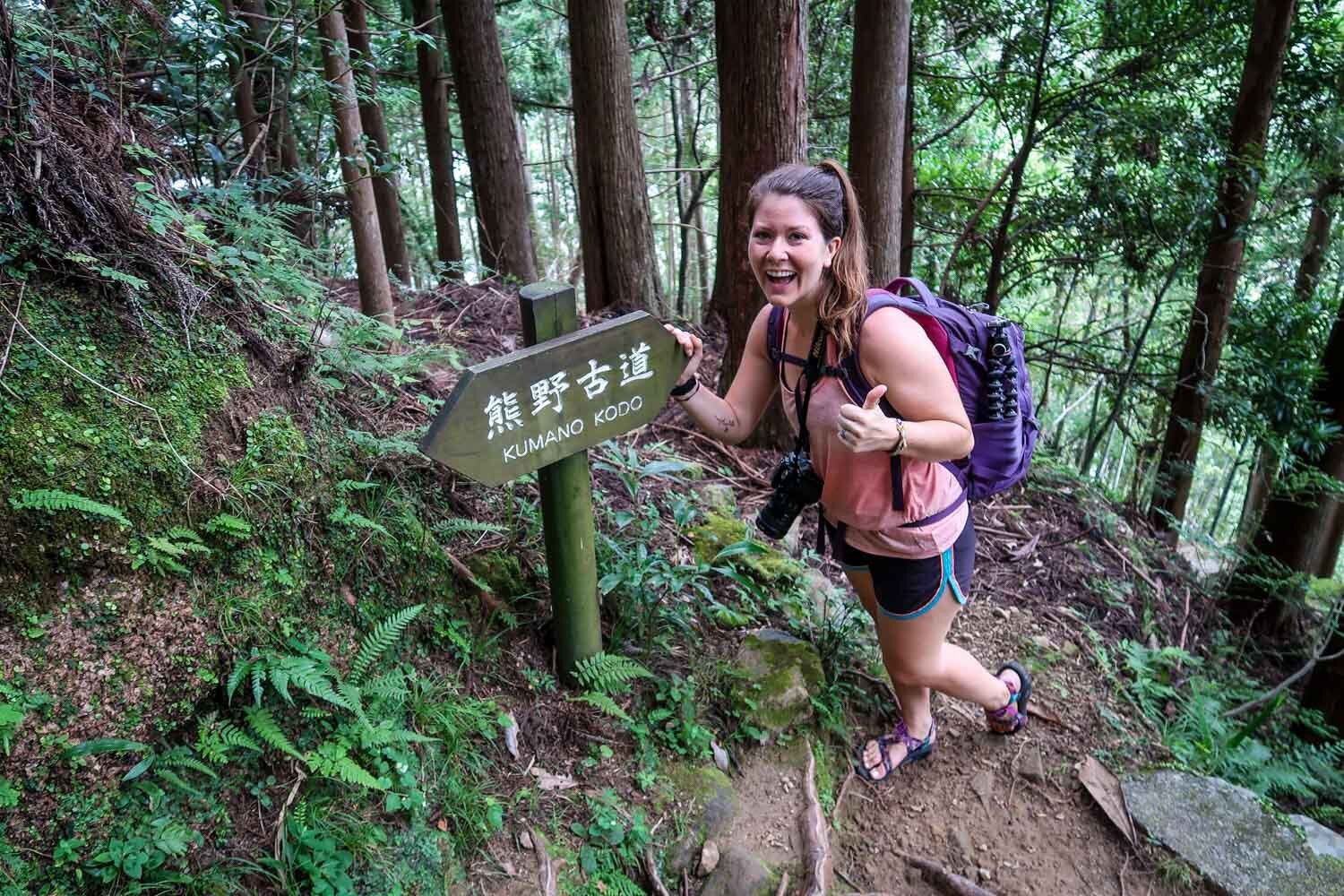
- Distance: 65 km (40 miles)
- Difficulty: Moderate
- Starting Point: Takijiri-oji
- End Point: Nachi Taisha
- Avg. Duration: 4-5 days
- Outline of the route
The most popular route, Nakahechi (known as the Imperial Route), spans across the peninsula’s width, and tallies in at just over 65 kilometers (40 miles). It takes most people between 4 – 5 days to complete.
Even within the Nakahechi Route, there are a few variations you can take.
The “main route” takes travelers from Takijiji-oji in the west to Hongu (38.5 km or 55 miles) in the center of Kii Peninsula. Variations include a short detour through Yunomine Onsen, and continuing on past Hongu to Nachi Taisha (one of the Three Grand Shrines of Kumano) in the east. (See the outline of the route above for variations.)
Nakahechi is the most popular route in Kumano Kodo and for good reason. We hiked a 2-day portion of this route from Yunomine Onsen to Nachi.
Kohechi Route: The Mountainous Route
- Distance: 65 km (40 miles)
- Difficulty: Advanced
- Starting Point: Koyasan
- End Point: Hongu Taisha
- Avg. Duration: 4 days
- Outline of the route
Starting from Koyasan in the north and connecting down to Hongu in the center of the Kii Peninsula, the Kohechi Route is 65 km (40 miles) in length. This is considered the hardest of all the routes because you trek over 4 mountain passes, all over 1000m (3,281 ft) in elevation.
This route typically takes 4 days to complete and should not be undertaken by anyone without proper preparation and in peak health.
Ohechi Route: The Coastal Route
- Distance: 37 km (23 miles)
- Difficulty: Advanced
- Starting Point: Kii-Tonda
- End Point: Mirozu
- Avg. Duration: 3 days
- Outline of the route
Perhaps the most unique route of the Kumano Kodo, Ohechi takes you along the southern coast of the Kii Peninsula with nice views of the Pacific Ocean.
Historically, the coastal route was much longer, connecting the seaside town of Tanabe with Nachi Taisha. However, the modern recommended route begins at Kii-Tonda and ends at Mirozu Station. This is because a large section of the route from Mirozu to Nachi has been paved over with modern highways.
Hiking the entire modern route takes 3 days, but you can do sections of this trail as day hikes. This is also the least popular of the Kumano Kodo routes, so you may get lucky and have the trail all to yourself.
Iseji Route: The Eastern Route to Kumano
- Distance: 182+ km (115+ miles)
- Difficulty: Moderate
- Starting Point: Ise Jingu Naiku
- End Point: Hongu or Nachi
- Avg. Duration: 2 weeks
- Outline of the route
Pilgrims visiting the Ise-jingu Shrine would trek down to the Kumano trails via over 180 km (115 miles) of sea sidewalks, bamboo forests, and mountain passes. Much of the route is actually paved with stone, making it one of the more unique trails in the Kumano Kodo.
This route can be further divided in 3 sections: North, Central and South. The southern section of the route splits at Hana-no-Iwaya, and takes you either west to Hongu or south to Nachi.
The entire eastern route is doable, but would take around 2 weeks complete. Most trekkers tackle shorter sections of the route in day trips or overnight hikes for 2-5 days.
3-Day Kumano Kodo Trekking Itinerary
Kumano Travel has extremely detailed itineraries detailing variations of mostly the Nakahechi Route. If you are considering doing a Kumano Kodo trek, we highly recommend researching further on this site.
(Note: we have no affiliation with Kumano Travel. They are just an awesome resource where you can book your accommodation and guide if you want one.)
In order to fit our travel time frame, we altered this 4-day/3-night itinerary from Kumano Travel. This is the 3-day itinerary we trekked on the Nakahechi Route of the Kumano Kodo trail:
Day 1: Transportation Day – Osaka to Yunomine Onsen

- 8:00 Wake up in Osaka
- 9:01 Leave Shin-Osaka Station toward Tennoji Station
- 9:23 Depart Tennoji Station toward Kii-Tanabe (using the Japan Rail Pass)
- Note: We recommend getting the Japan Rail Pass when traveling to Kumano Kodo. The trip there and back from Osaka basically makes up over half of the 7-day pass. When you have the JR Pass, you can travel freely on any JR line including the Shinkansen Bullet Trains.
- 11:22 Arrive at Kii-Tanabe Station
- Visit the Tanabe Tourist Information Center right next to the station to pick up maps and other information. Have lunch near the station, or grab something to go.
- 12:50 Buses leave right outside of the Information Center. At bus stop #2, hop on bus #81 or #85. Here is the local bus timetable.
- How to Ride the Bus: Enter from the back of the bus and take a small ticket from the machine by the door. It will have a number on it corresponding with the stop number. There is a monitor (in English and Japanese) displaying the stops. Push the Stop button on the wall when you see Yunomine Onsen. As you exit out the front of the bus, pay the driver in cash in the bus fare machine.
- 14:37 Arrive in Yunomine Onsen. Check into your guesthouse. We stayed at J-Hoppers Guesthouse and recommend it!
- 15:00 Take the rest of the day to explore Yunomine Onsen and relax.
- Reserve a half-hour spot in 1000-year old Tsubo-yu, the UNESCO World Heritage hot spring in the center of town.
- Soak in your own private onsen at J-Hoppers.
- Boil eggs for morning or get snacks at the convenience store.
- Cook dinner at your guesthouse and socialize with other hikers.
Day 2: Hongu Taisha to Kogumotori-goe Trail to Koguchi
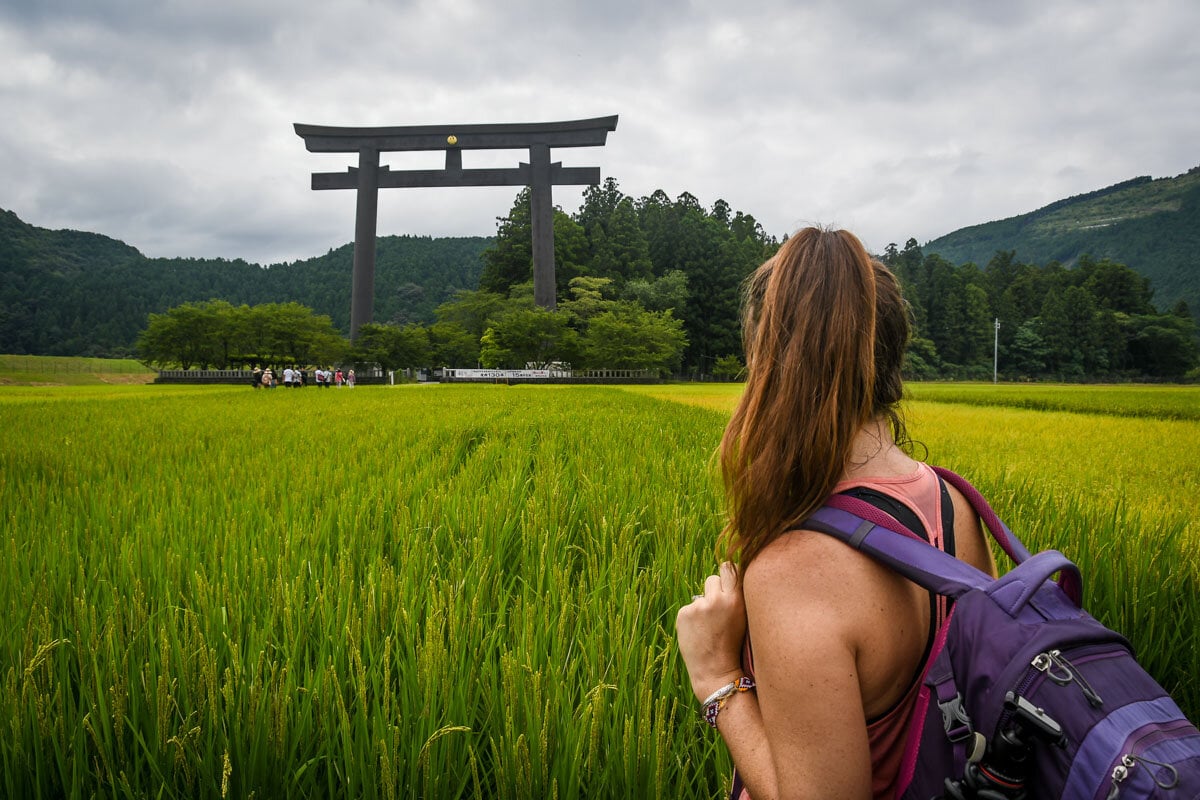
- 8:00 Wake up in Yunomine Onsen
- 9:00 Start hike to Hongu
- 10:00 Arrive Hongu
- Explore Oyunahara and Hongu Taisha Shrine.
- Pick up lunch in town at the bakery.
- 11:15 Bus leaves from the Hongu visitors center to Ukegawa Trailhead (Kogumotori-goe Trail)
- Tell the bus driver you want to get off at Ukegawa.
- 12:30 Lunch on the side of the trail. Pack out your trash.
- 13:00 Continue hiking
- Be sure to stop at Hyakken-gura viewpoint
- 16:00 Reach Kowaze-Bashi bridge and follow signs toward Koguchi
- 16:30 Arrive in Koguchi and time for a swim in the river!
- 18:00 Have a delicious dinner at your guesthouse.
Day 3: Koguchi to Nachi Falls (option to Katsuura)
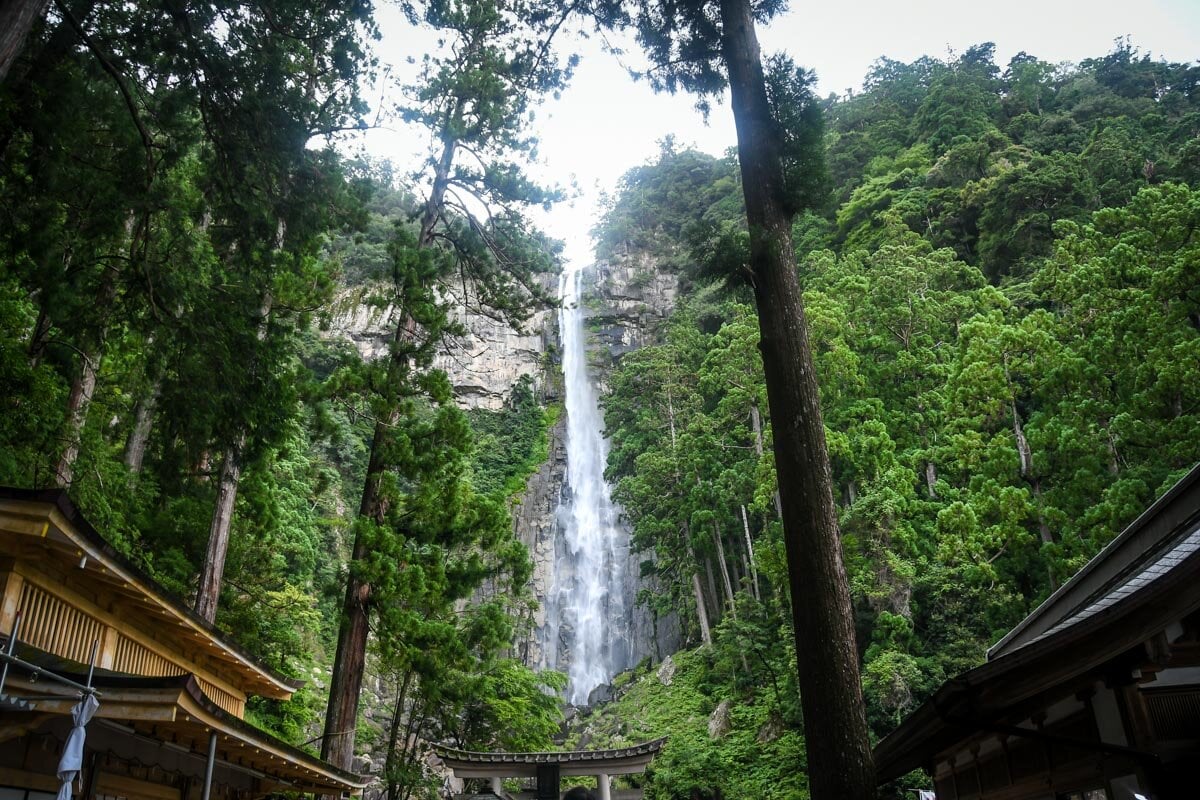
- 7:00 Wake up in Koguchi
- 7:30 Breakfast at guesthouse
- 8:00 Leave for Hike
- Note: During summer months, there was a water spigot at trail marker #26
- 9:45~10:00 Approach the base of Echien Pass. Prepare for the “bone-breaking slope”
- 10:30 Reach top of Echien Pass
- 11:45 Jizo-jaya Teahouse Remains (nice shelter for lunch)
- 15:15 Reach Nachi
- Note: Best view of three-tiered pagoda and waterfall: As you reach the end the stairs coming off the trail, turn left and walk toward the three-tiered pagoda. There is a staircase going down next to the parking lot. From the top of the staircase, look down, and you can see the best view platform which is right next to what looks like a hotel. Walk down the stairs, turn right and up the ramp next to it and you’ll be there. In total is about 3-5 minutes from the end of the trail.
- 16:00 Walk to Nachi Falls. It’s free to walk all the way up to the falls, but it costs 300 yen to get a closer look on the viewing platform. The view from the bottom was pretty good so we didn’t feel the need to visit the platform.
- 17:10 Take the bus to your guesthouse or down to Katsuura (25 minutes from Nachi) if the guesthouses around Nachi are full, as they were for us. We stay in Katsuura at Why Kumano hostel.
Optional Day 4: Transportation Day – Katsuura back to Osaka
- 7:00 Every morning in Katsuura (except Tuesdays and Sundays) there is a tuna auction from 7-8 am down at the docks. It looks like the famous Toyosu Fish Market in Tokyo, but a much smaller scale.
- 8:00 Breakfast at Fish Market
- 8:53 Depart Kii-Katsuura to Osaka on a bullet train using your JR Pass
Highlights along the Kumano Kodo trail
While some of our favorite parts of the trail were unmarked stretches where we were entirely alone and surrounded by towering cedars, there are several points of interest along the Nakahechi Route that are worth visiting.
Takijiri-oji
This is the beginning town on the Nakahechi Route of the Kumano Kodo trail. Here you can visit the Kumano Kodo Kan Pilgrimage Center and one of the five major Oji shrines.
Takahara
If you are hiking the full Nakahechi route, this small settlement would be your first. Known as the “Village in the Mist” as the rolling fog is common and quite a sight from the vistas above.
Tsugizakura-oji
Visit this small shrine surrounded by massive 800-year old cedar trees. All of their branches point south toward Nachi Falls.
Yunomine Onsen

We recommend spending a night in this quaint mountain village, recognized as one of Japan’s oldest onsen towns. The town is home to Tsuboyu, one of the only UNESCO World Heritage hot springs in the world. You can purchase a bag of raw eggs from the convenience store next to the river and hard boil them in the hot spring. It makes a nice snack for the next day’s hike.
We stayed here our first night after taking the bus from Kii-Tanabe. We highly recommend J-Hoppers Kumano Yunomine Guesthouse because they have private onsens you can relax in and they offer free rice at night to go with your meal.
If you get to J-Hoppers early enough in the day, you can rent a hybrid bike for 1500 yen and pedal 20-30 minutes to a public onsen pool called Kawayu Onsen. Visitors must wear swimsuits.
Hongu Village
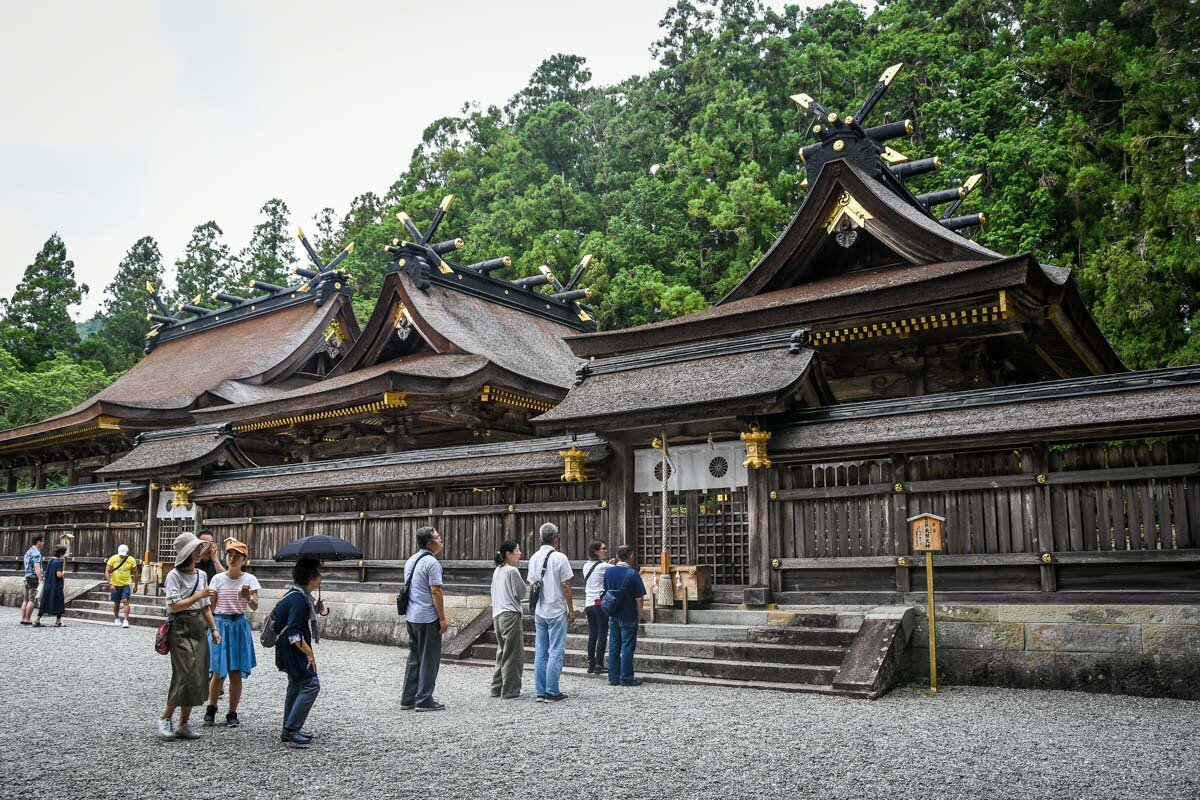
A steep 1-hour hike from Yunomine Onsen will bring you to Hongu. Visit Hongu Taisha, one of the three grand shrines. In Hongu, you can grab snacks for the day and visit the Kumano Kodo visitor center for any trail updates.
Oyunohara
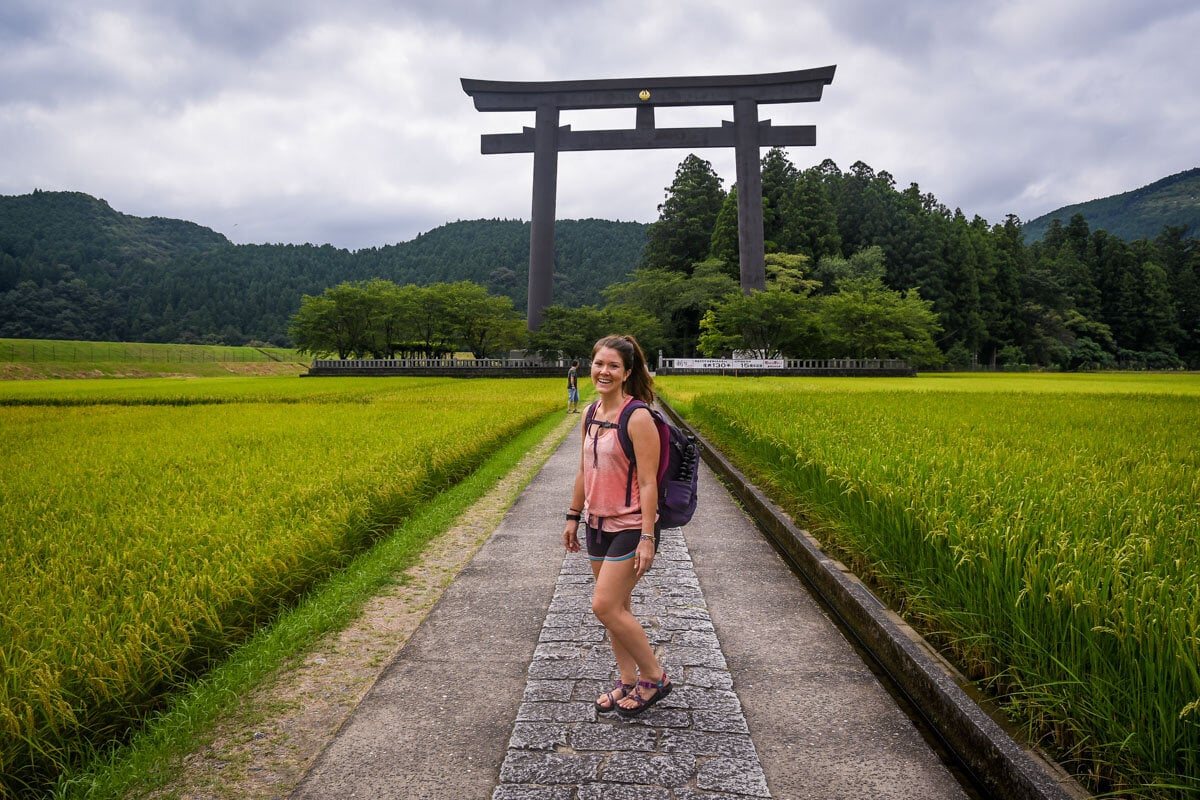
The Hongu Taisha Shrine once stood at the banks of the confluence of the Kumano and Otonashi Rivers, until a severe flood destroyed most of the structures in 1889. That’s when the shrine was moved to the hill where it still resides today.
You can still see the platform where the structures once stood. The entrance to Oyunahara is denoted by the largest Torii gate in the world (33.9 meters tall and 44 meters wide). All routes in the Kumano Kodo go past this Torii Gate and you are free to enter, but know that it is a sacred site so be respectful.
Hyakken-gura

This viewpoint on the Kogumotori-oge section of the trail between Hongu and Koguchi was our favorite on the entire trail. It is said that on a clear day, you can see 3,600 mountains from this vista.
Koguchi

We spent a night in this small village and took a dip in the river which was beyond refreshing after a long day of hiking in Japan. There is not much in the town, but for our second night on the trail, we stayed at Minshuku Momofuku homestay which is run by a lovely elderly couple.
It was one of the more expensive stays in all of Japan, but totally worth it because they prepared dinner, breakfast and a to-go lunch for us the next day.
Echizen-toge Pass
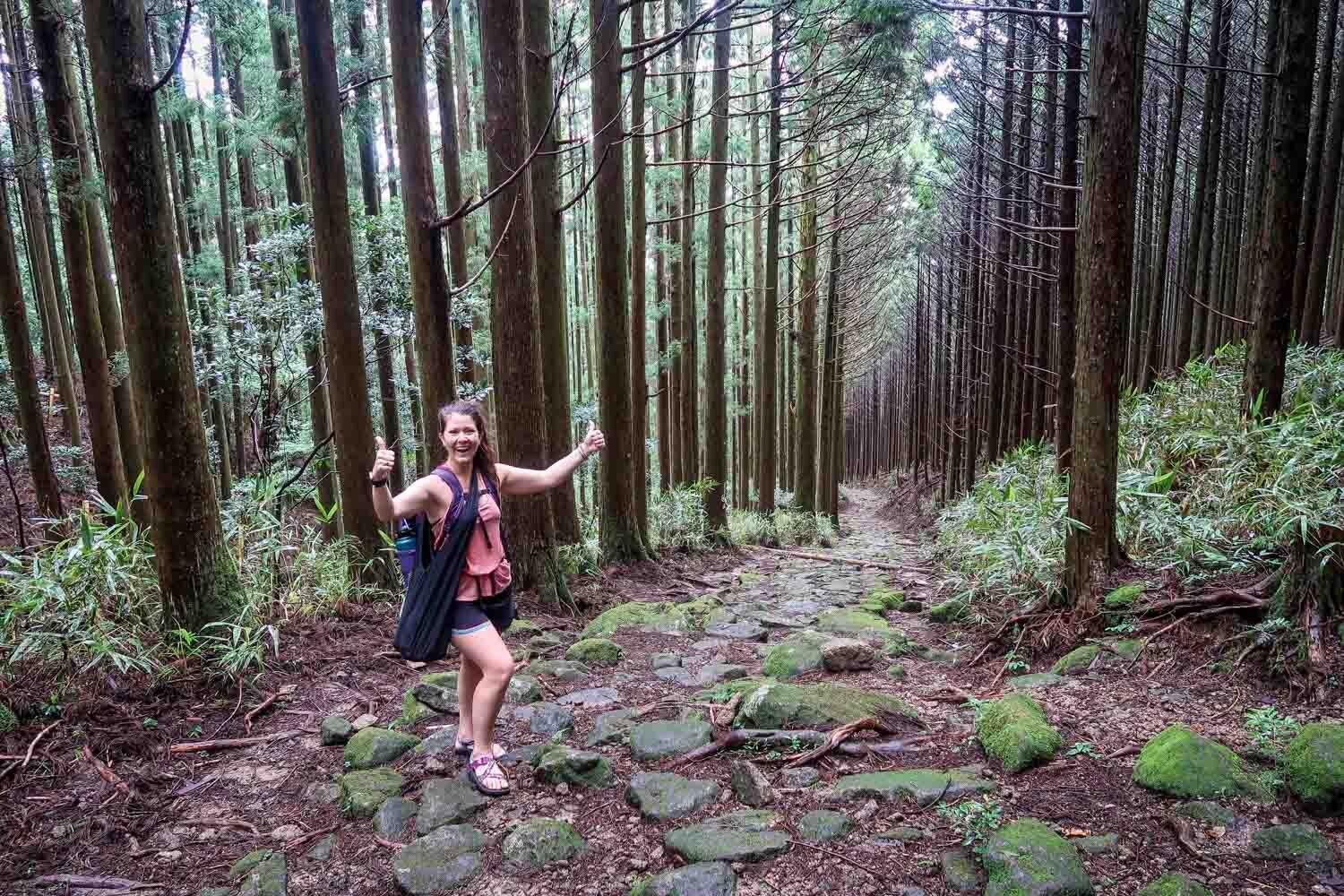
As you approach the pass, sign prepare you for what is called the “bone-breaking slope”, and they are not joking. It’s a long climb up to 870 meters but the rest of the day is relatively flat compared to this.
Nachi Falls
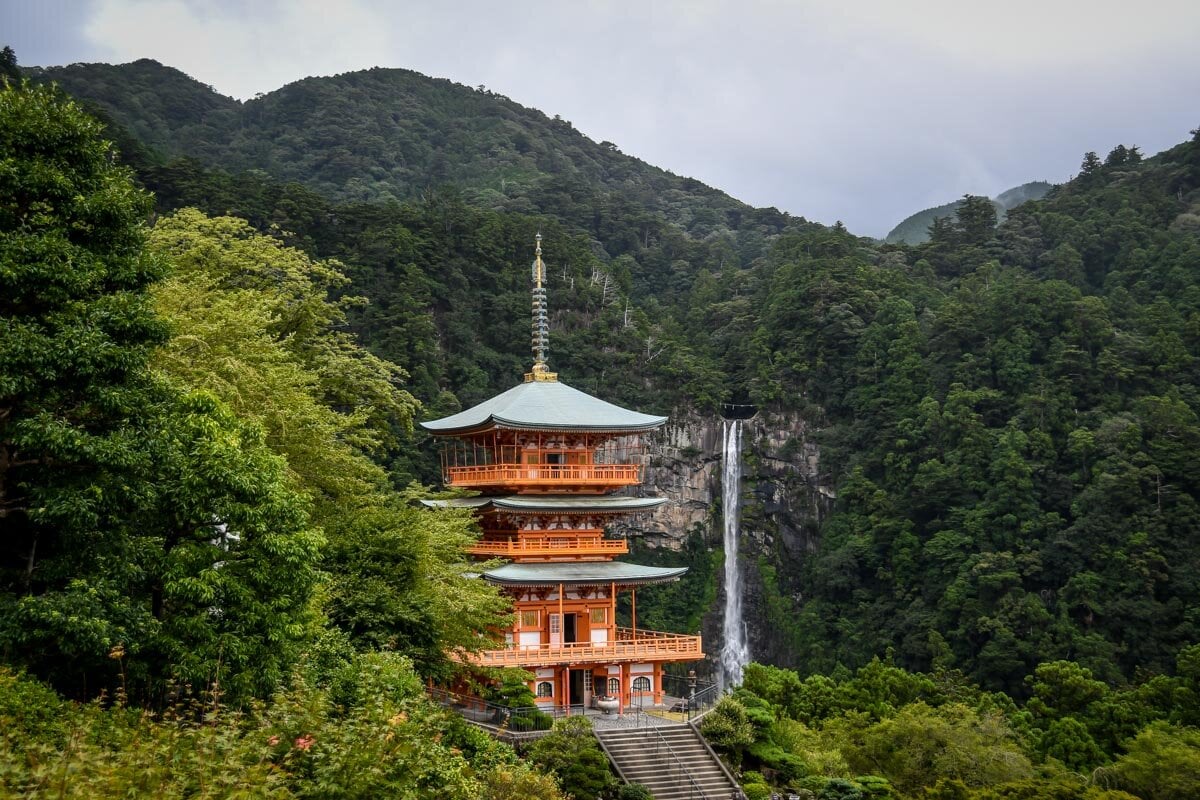
Measuring 133 meters (436 feet) high, Nachi is Japan’s tallest waterfall, and crashes beautifully over the cliffside behind Nachi Taisha, the second and most famous of the 3 grand Kumano shrines.
If you are able to book guest houses in this area, it would be nice because you could take the bus to visit the falls in the morning. Unfortunately, everything was booked for us so we stayed in Katsuura.
Katsuura

This seaside town can act as a good base for beginning or ending the Kumano Kodo (if the rooms near Nachi are booked, as they were when we were there).
There is a tuna auction every morning from 7-8 am (except Tuesdays and Sundays) down by the docks. After the auction, go inside the market and order fresh sushi for breakfast!
We stayed in a hotel called Why Kumano which had friendly staff and a nice coffee shop attached.
How to book accommodation on the Kumano Kodo
When planning out your Kumano Kodo trek, it’s important to book your accommodation ahead of time. Guesthouses are limited, and some only have a couple of rooms, so they can fill up quickly, especially during popular trekking months.
There are limited options on sites like Booking.com, and many of the smaller villages don’t even show up on booking sites.
So how do you make reservations?
We booked all of our accommodations through Booking.com and Kumano Travel, a local agency that is part run by the Wakayama Tourism Organization.
Here are the places we stayed and we would recommend them all:
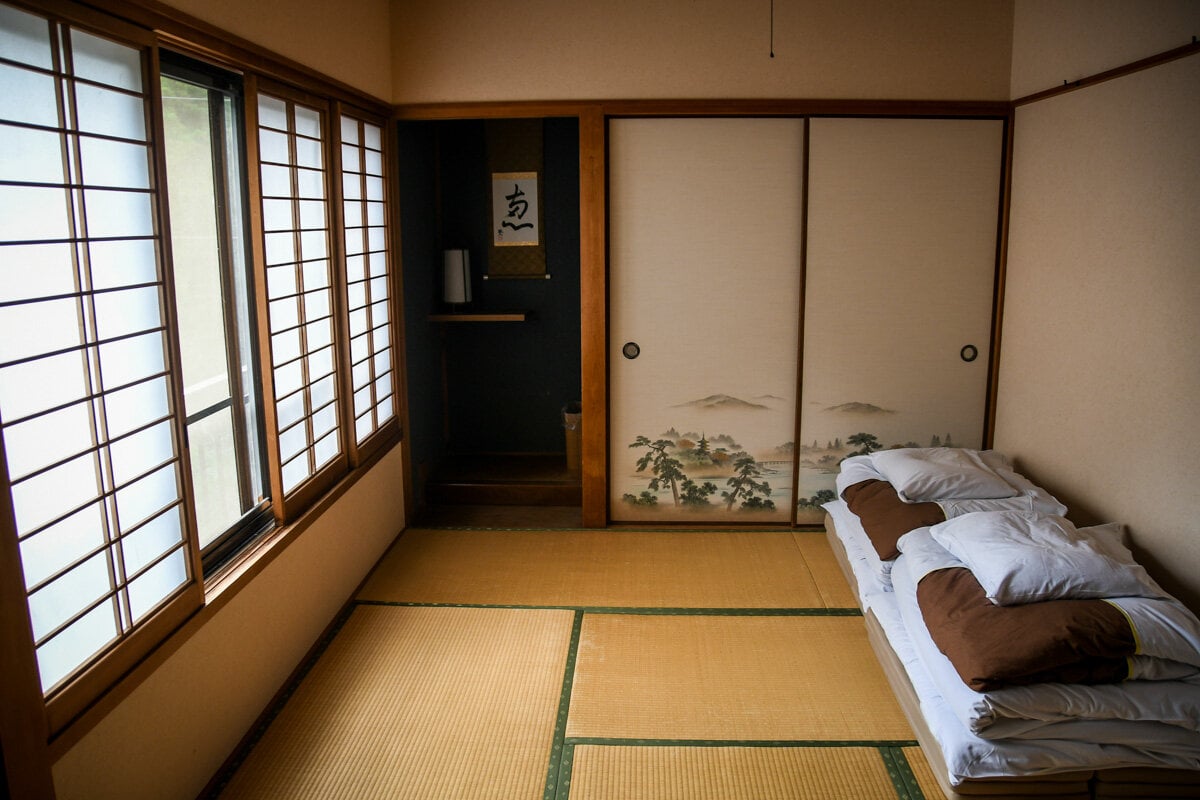
J-Hoppers Kumano Guesthouse in Yunomine Onsen
Stay in a traditional Japanese style room with cosy futons on the floor and shared bathrooms down the hall. The kitchen has all the cookware you can imagine so why not cook your own meal before you start the Kumano Kodo trek. They provide free fresh white rice at dinner time and rice porridge at breakfast.
But the highlight of the guesthouse were the three private onsens. We were able to grab the only open-air hot spring and soaked for a while (as we sipped on a little wine!).
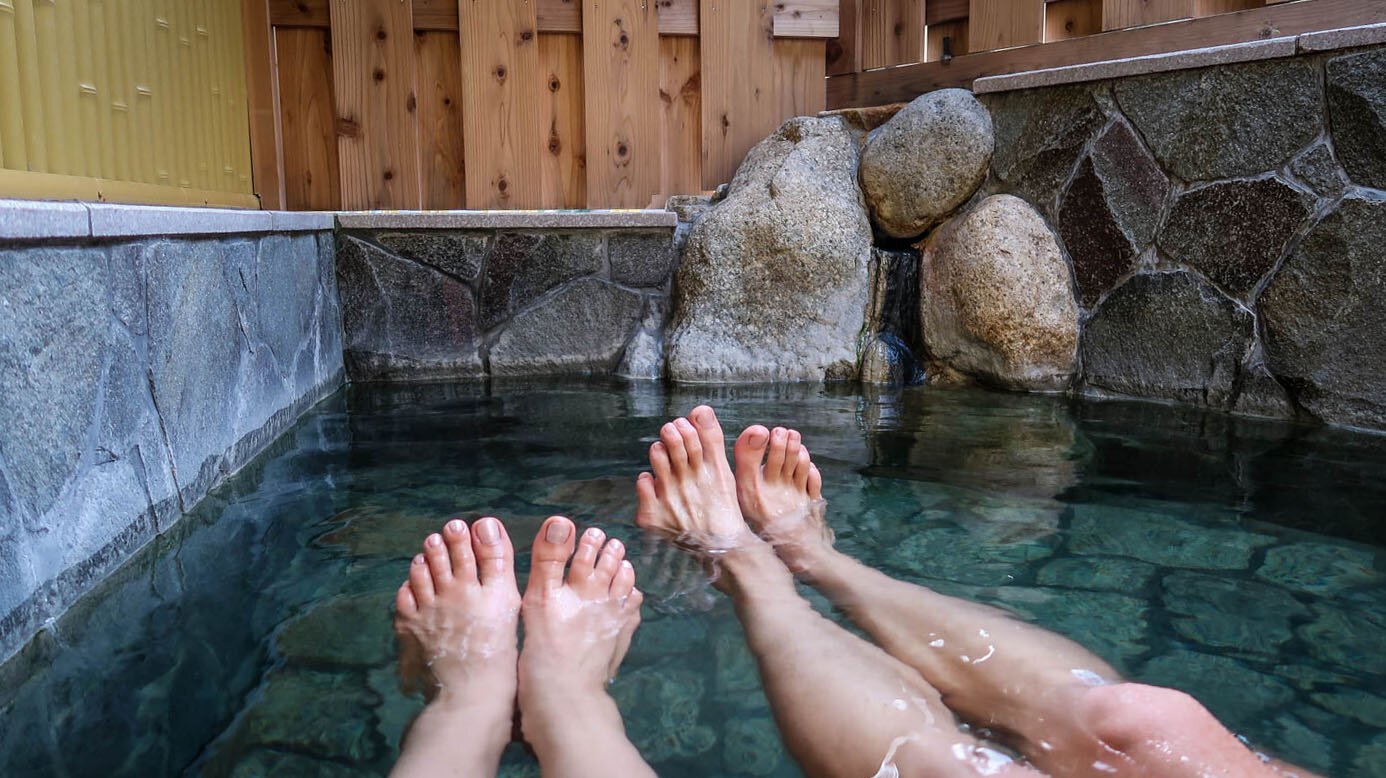
J-Hoppers is super close to town and had a nice social atmosphere. You can book a night here on either Booking.com or Kumano Travel. Check availability for your dates.
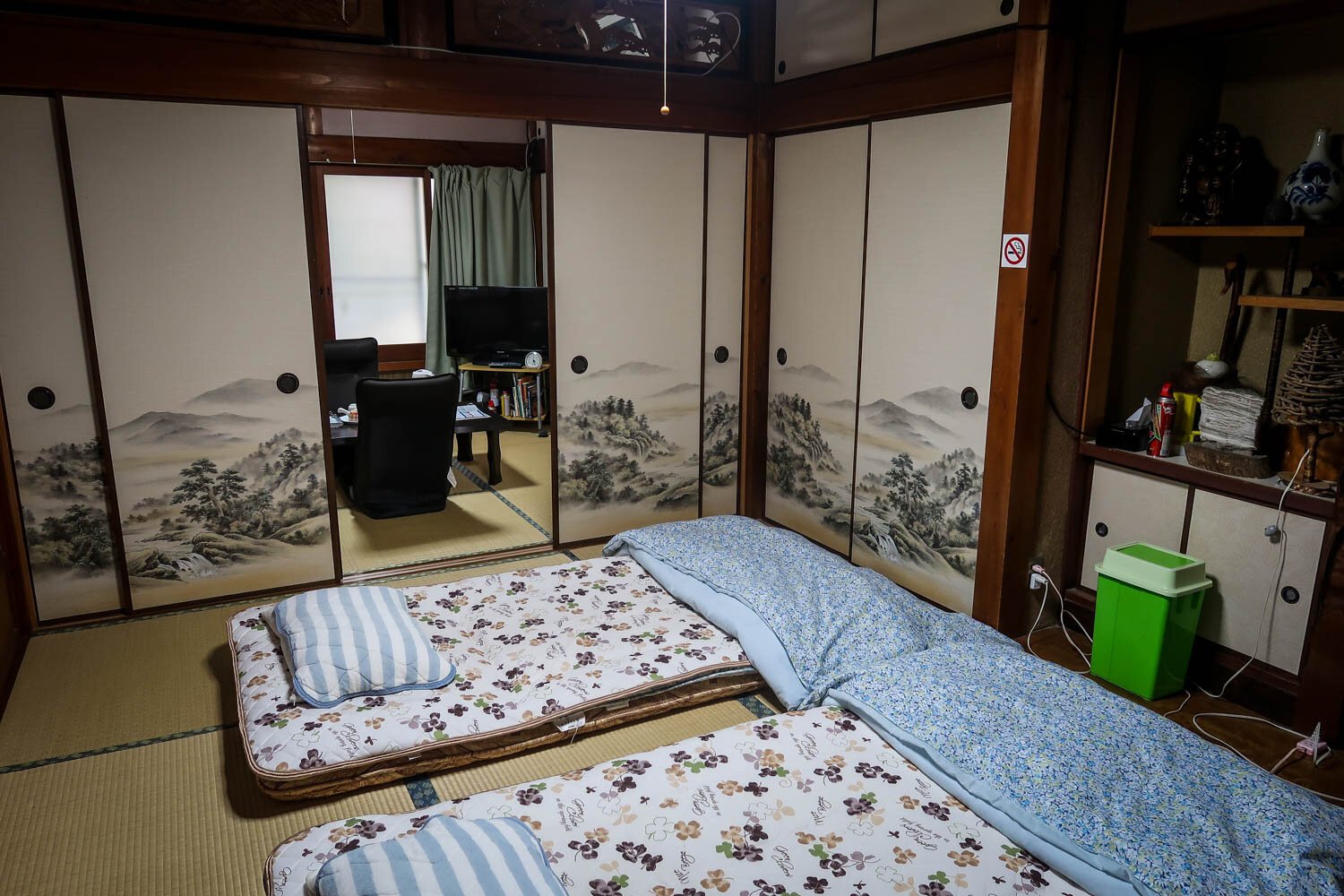
Minshuku Momofuku in Koguchi
Run by an adorable elderly Japanese couple, staying at Minshuku Momofuku was a highlight of our time on the Kumano Kodo Trail. They welcomed us with open arms and brought us into their home. The husband spoke English pretty well as he showed us around the house. Steps away from their home was the river that ran through the village. Nothing felt better than taking a dip in crystal-clear water after a long hike.
The best part of our stay were the meals they prepared. For dinner and breakfast, we were spoiled by their home-cooked meals of local fish and vegetables. They even prepared a lunch to-go for us to have on our hike.
If you plan on staying in Koguchi, we highly recommend Minshuku Momofuku, but if they are not available you can browse the other guesthouses in Koguchi.

Why Kumano Hostel in Katsuura
Literally 100 feet from the Kii-Katsuura train and bus station, Why Kumano Hostel could not be more conveniently located. They only have dorm rooms and the beds are compartment style (kind of like a wooden capsule hotel) so it may not be for everyone, but we figured it was just one night so we would manage.
The staff was very friendly and even helped us do laundry, which was much needed after two days on the trail (500 yen for a load). The reception doubles as a cafe where you can get a good americano before you head out in the morning. If you don’t mind sleeping in a dorm room it is a great place to stay in Katsuura. Check availability for your dates.
Food on the Kumano Kodo
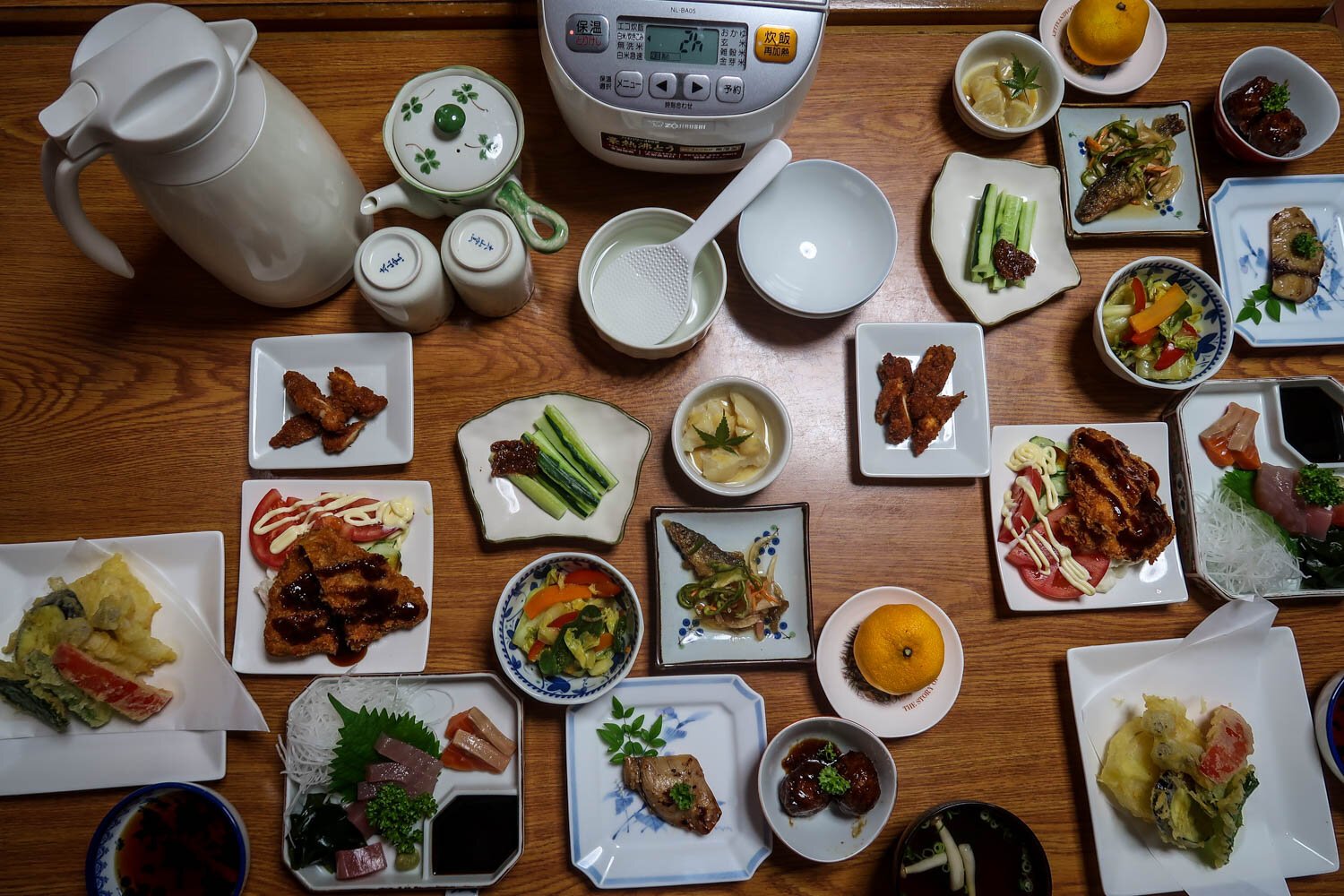
I’ve got good news for all you foodies – you’ll have some incredible food during your Kumano Kodo hike.
Many of the guesthouses along the Kumano Kodo include meals with your stay. Minshuku Momofuku, the guesthouse we stayed at in Koguchi included a gigantic dinner, breakfast and even a packed lunch for us to bring with us the next day. The food was clearly lovingly prepared and featured local ingredients and lots of fresh fish.
As you are hiking, there are many stretches where you will not have access to towns or any food. For this reason, we’d definitely recommend bringing along a few snacks.
Are you vegetarian? One important thing to note is that vegetarianism is not common in the Japanese countryside, and this can be difficult to fully accommodate. When you make your reservation at guesthouses, there is usually an option to select if you don’t eat meat. However, there may still be dashi (fish stock) used in some of the cooking. More info: Check out this guide to Japanese food, which has some useful info for traveling in Japan as a vegetarian.
What to pack for hiking the Kumano Kodo trail

Since you’ll need to carry everything with you on this trek, it’s important to pack light. Here are some of the essentials:
- Comfortable day pack
- Packing Cubes: this will keep your clothing organized and compressed inside your day pack so it’s not a huge mess
- Clothes for hiking & layers (depending on the time of year)
- Rain jacket
- Clothes to change into at night
- Hiking shoes: We wore them when we did the Kumano Kodo in the summertime (and they were perfect for us!), but during cooler seasons, we would have worn hiking boots or sneakers instead.
- Battery pack for charging electronics
- Water Bottle and/or Camelbak: remember, it’s safe to drink from the taps in Japan, so you can fill up in towns along the way
- Dry bag: If you encounter rain along the trail, you’ll be happy you have a safe place to store any electronics (it happened to us!)
- Camera: Canon PowerShot G7x – high-quality photos and compact enough to stash in a bag.
- Snacks: We’d recommend stocking up on some snacks in a bigger city, like Osaka. Or better yet, pack granola or protein bars, trail mix, beef jerky, etc. from home, as these types of hiking snacks can be difficult to find in Japan.
- Kindle or book: for reading at night
- Toothbrush & toothpaste (and other essential toiletries)
- Hiking poles (optional): We chose not to bring poles and were fine (we typically do not use them), however, if you are used to hiking with poles or have bad knees, it might be a good idea.
- The visitors center near the Kii-Tanabe train station offers free bamboo sticks for hikers to use as trekking poles, as well as “passport books” to collect stamps at points along the way (just for fun!)
Insider Tip: Only bring what you need on the Kumano Kodo. Leave the rest of your luggage at your hotel in Osaka (or wherever you’re staying before and after the hike). If you need your luggage transported, there are services for that! Choose any one of the services from the Kumano-Travel.com which ranges from $10 to $60 USD depending on the distance.
What to pack for traveling to Japan
We know it can be overwhelming packing for a trip to a new destination. That’s why we spent hours creating this super helpful PDF just for you.
In this FREE Japan packing list PDF download, we’ve provided packing checklists for everything from clothing and toiletries (for both women and men!) to what shoes to pack and extra stuff you may want to have on-hand just in case.
Plus, we’re sharing tons of packing hacks and tips for traveling in Japan that you won’t find anywhere else!
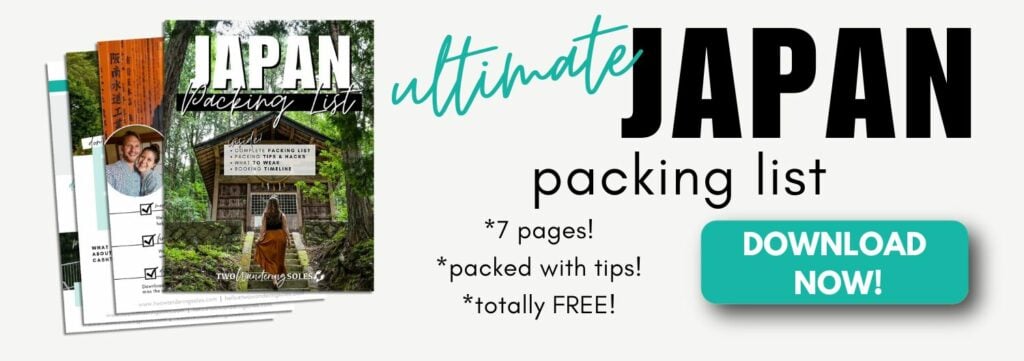
Travel tips for the Kumano Kodo
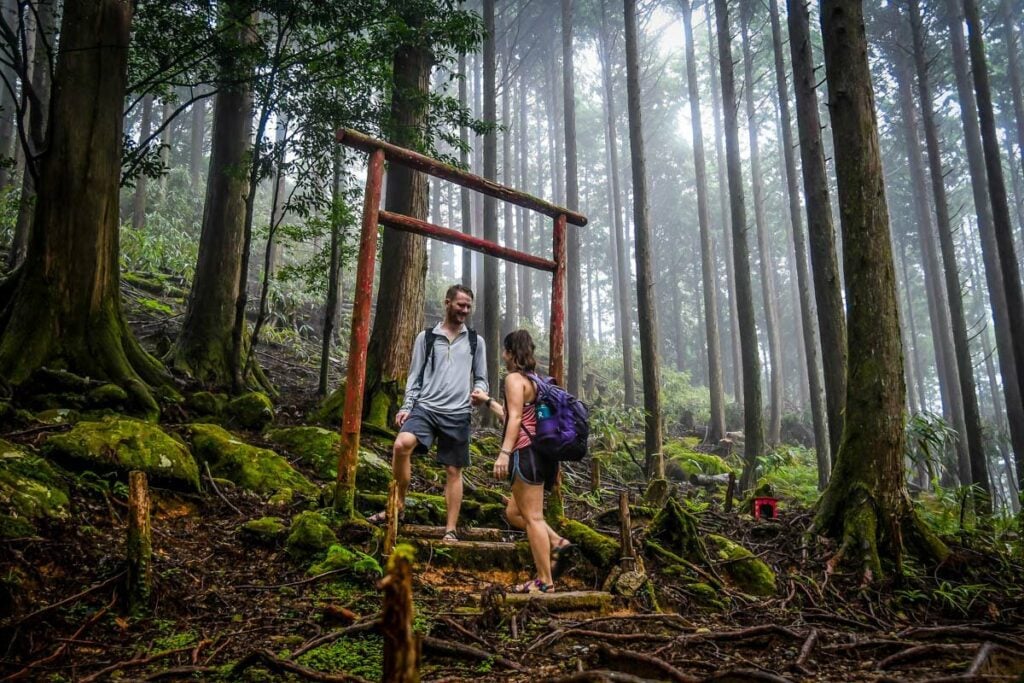
- Book accommodation ahead of time. The villages along this route are small, and rooms are limited. When they book up, you’ll be out of luck.
- Example: When we booked our accommodation, there were no rooms left by Nachi Falls, so we had to be sure to catch the last train of the day to Katsuura. We would have preferred to stay near the falls in order to see and photograph it in the morning light, but we were outta luck!
- Download maps, because you may not have cell service the entire time.
- Download Google Maps and Maps.me maps for the region. Maps.me does a great job at highlighting trails and points of interest. You should also get the trail maps from Kumano-Travel.com which show in detail what to expect along the hike.
- Download the Japanese Language Pack on Google Translate. In the countryside, many people do not speak English. Don’t worry though, this app makes it pretty easy to communicate! Here are a few other apps you might want for Japan.
- You might also find it helpful to learn a few basic Japanese words and phrases before your trip.
- Pack snacks. There is not much access to snacks along the way, and if you do find some options in bigger towns like Hongu, there isn’t a ton of variety.
- Bring rain gear. It is known to rain all year round in this region, so you’ll want to be prepared.
- Store your luggage so you don’t have to carry it all on the trail. We were returning to the same hotel in Osaka, and they kindly stored our luggage for us, free of charge. Email your hotel in advance to see if they could accommodate this request.
- Not returning to the same hotel? We used a luggage transfer service called Yamato Transport to store our luggage and transfer it from Osaka to Tokyo. It was cheap (just $25 USD, but can be as low as $15 USD depending on size), and so convenient! (We had been living in Asia for the better part of a year, and had a lot of stuff with us that we didn’t want to lug around on the Japanese trains!)
- Account for the time getting to and from the Kii Peninsula. You’ll need to have a good chunk of time on either end devoted to train and bus travel, so be aware of this as you plan your day before the trek and the day after.
- Bring Cash (in small bills if possible): You’ll be traveling to small mountain towns that don’t always take credit cards or have ATM’s. Be sure to know if you have paid for your accommodation beforehand or not and bring enough cash accordingly.
How much does it cost to hike the Kumano Kodo?

Japan is a notoriously expensive destination, and in some ways, the Kumano Kodo is no exception. Accommodation along the trail is limited, and therefore, not entirely cheap.
Here are some examples of what we paid for accommodation (for 2 people):
- 1-night stay at a family-run guesthouse with dinner, breakfast, and lunch included: $187 USD (19,800 yen)
- 1-night stay at a budget guesthouse, no meals included: $114 USD (12,100 yen)
- 1-night stay (in dorm beds) in a hostel in Katsuura after our trek (no meals included): $99 USD
But outside of accommodation, food, and a few bus rides, you won’t really have any other expenses because the hike itself is free. And hey, when you’re in nature all day, you’re not gonna be tempted to go on a shopping spree!
Tip: You may want to budget a bit of money for a bottle of wine to enjoy after a long day of hiking! We found the brand Alpaca available at some convenience stores in the region was actually an alright wine for around 700 yen ($7 USD).
How much did we spend during our entire Kumano Kodo Hike?
The total for 3 days / 3 nights for two people was ¥53,500, or $490 USD. That averages out to about $82 USD per person per day, which isn’t all that bad for Japan when you think about it.
This includes all accommodation, food, transportation within the region (buses that aren’t part of the JR Pass), and a few adult beverages!
How to get to the Kumano Kodo
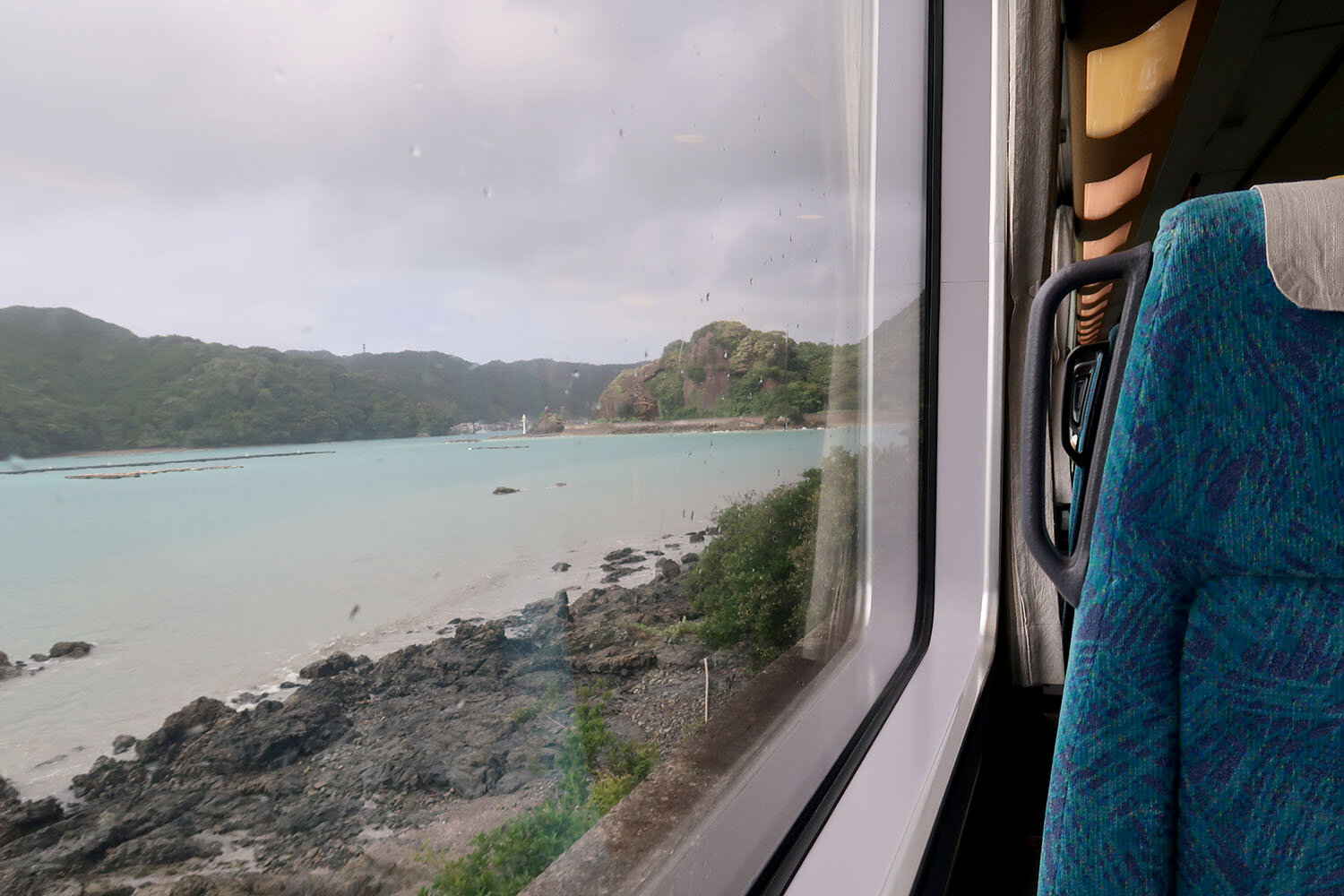
Whether you’re coming from Tokyo, Osaka, or anywhere in between, you’re going to start this trail in one of two places (Nakahechi Route – most common):
- Tanabe in the western part of Kii Peninsula
- Katsuura in the southeast of Kii Peninsula
The route we took was from Osaka’s Tennoji Station to Tanabe Station (sometimes called Kii-Tanabe).
The nice thing about traveling around the Kumano Kodo is that each town or village is connected on a bus route. So if you don’t want to hike a portion of the trail or if your plans change, you can take the bus to the next town. Here are some of the key bus routes in the region.
How to ride the bus
Enter from the back of the bus and take a small ticket from the machine by the door. It will have a number on it corresponding with the stop number.
There is a monitor (in English and Japanese) displaying the stops. Push the Stop button on the wall when you see the stop you want to get off. As you exit out the front of the bus, pay the driver in cash in the bus fare machine.
You’ll want to keep an eye on the time because, in true Japanese fashion, everything is on time, even buses. And most places in this region close early, and the same goes for the buses.
Don’t expect buses to run after 5 or 6 pm.
We took 3 buses in the region (1 long distance and 2 short distances) and the total we spent per person was 1,940 yen ($18 USD).
Important Note: While the entirety of your transportation will not be covered by the JR Pass (you’ll need to take some local buses), just getting to the Kii Peninsula and back out is likely to make getting a JR Pass well worth your money. Read all about how to calculate if the JR Pass is worth it for you.
Kumano Kodo FAQs
We’re trying our best to answer some common questions about this hike. If you have a question that you don’t see answered here, be sure to write to us in the comments below and we’ll get back to you!
How hard is the Kumano Kodo?
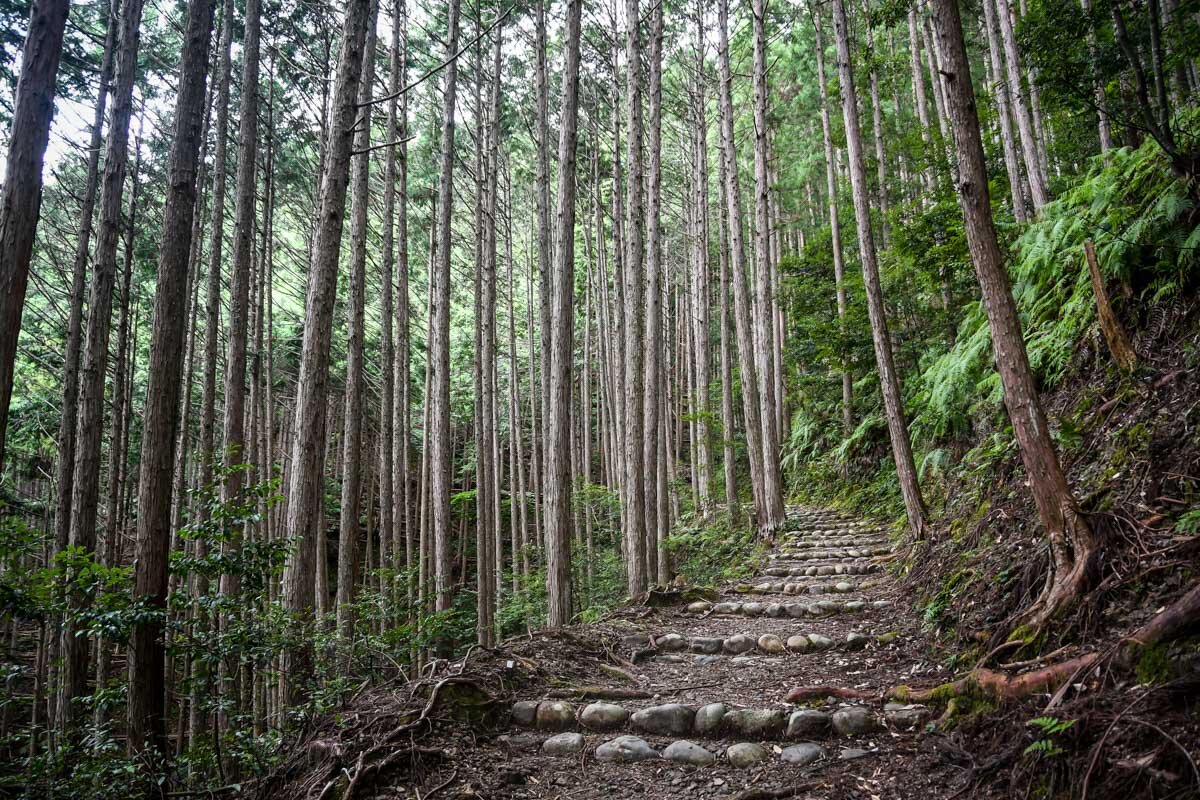
This is a difficult question to answer because it varies from person to person based on their prior experience. It is also going to depend on which route you take, as different sections of the trail are steeper than others.
We do quite a bit of hiking, and we felt like this trail was moderate. You won’t feel any effects of elevation, and the paths are well-maintained and clearly marked. There are some very steep sections, but there are also many flat areas to balance it out.
The most difficult part, in our opinion, was the stretch from Koguchi to Nachi Taisha at the end of the route (Day 3 on our route). This is a long day – it took us about 7 hours from start to finish, and there are many steep sections. Another thing to note is that you don’t cross any towns or villages along the way, so you need to be sure to bring enough water and food on this day.
What ages is the Kumano Kodo Trail suitable for?
We think anyone who is relatively fit and likes to hike would be able to enjoy the Kumano Kodo, either in its entirety or just a portion.
We saw a handful of older people doing this hike (60s – 70s), and while we didn’t see any children, I’m sure kids do make this hike (as long as parents know their limits and are prepared). This hike wasn’t any more challenging than others that we’ve seen children on.
How crowded is the Kumano Kodo Trail?

This is going to vary throughout the year, as some seasons are more popular for hiking in Japan (I’m talking about you, Spring and Autumn!) than others.
We did the Kumano Kodo in August, and on each day of our hike, we counted fewer than 10 other people. I mean, can you imagine any greater contrast to Tokyo’s infamous crowds?! I will point out that during certain times of the year, it can get busier than what we experienced in August. However, it is still far from the crowds you may associate with Japan.
And this under-the-radar reputation may not last long…
Lonely Planet named the Kii Peninsula as one of the “top 10 regions” in their 2018 Best in Travel Awards, so I think it’s only a matter of time before this trail becomes more well-known amongst general travelers.
Good to know: Another major point to mention is while it may not be crowded, the small towns along the way don’t have all that much accommodation. So it is important to book your rooms in advance, no matter which time of year you’re traveling.
Read next: We’ve rounded up all the things Japan is most famous for in a guide that’s also packed with practical travel tips. Plus, we’re sharing a few things we personally think Japan should be famous for, but most foreign tourists are surprised to know (spoiler alert: one of those things is hiking!).
Other epic hikes to add to your bucket list
If you’re reading this article, I imagine you’re a hiking enthusiast. We’ve done some pretty epic hikes around the world and created guides to help you navigate the same trails we have.
- Tongariro Crossing, New Zealand: Widely considered to be the best day hike in New Zealand, this is a can’t-miss if you’re visiting the North Island.
- Routeburn Track, New Zealand: If you’re traveling in New Zealand, you’ll want to add this hike to your list as well. This multi-day trek on the South Island is one of the best hikes in the country.
- Fimmvorduhals Hike, Iceland: This is one of our very favorite day hikes ever, and if you like the Tongariro Crossing, this should also be on your list!
- Old Man of Storr, Scotland: This hike on the Isle of Skye brings you up close to some otherworldly rock formations.
- Volcan Acatenango, Guatemala: This overnight hike just outside Antigua allows you front seat views to watch the neighboring Volcan Fuego erupt all night long.
- Ijen Crater, Indonesia: This classic sunrise hike in East Java ends with epic views over a neon blue crater lake.
- Inca Trail: This classic trek in Peru is worthy of a top spot on your hiking bucket list.
- Everest Base Camp: If you’re looking for a hike you’ll be telling your grandkids about, this is it! Stay at tea houses along the way and make lifelong friends.
Plan your trip to Japan
After 3 trips (and counting!), we’ve fallen head over heels for Japan—and we’ve created TONS of resources to help you plan your dream trip. Start with our Ultimate Japan Travel Guide and be sure to check out these helpful articles:
- First time? Our Japan Trip Planner walks you through everything you need to know.
- Use our Japan Rail Pass guide to determine if getting a train pass is optimal for your trip.
- Here’s our curated list of the best things to do in Japan—from iconic sights to once-in-a-lifetime experiences.
- Not sure where to go? Our Japan itinerary ideas will help you map it all out.
- Foodies, rejoice! This guide to what to eat in Japan will have you drooling before you land.
- This guide to what to wear in Japan (and what not to wear) will help you blend in.
- Use our ultimate Japan Packing List to make sure you don’t forget anything.
- Before you go, brush up on these essential Japan travel tips (including major do’s and don’ts!).
- Avoid awkward moments by brushing up on Japanese etiquette.
Still have questions? Drop us a comment—we LOVE helping travelers plan unforgettable trips to Japan!
Perfect Japan itinerary
Want the perfect itinerary planned for you?
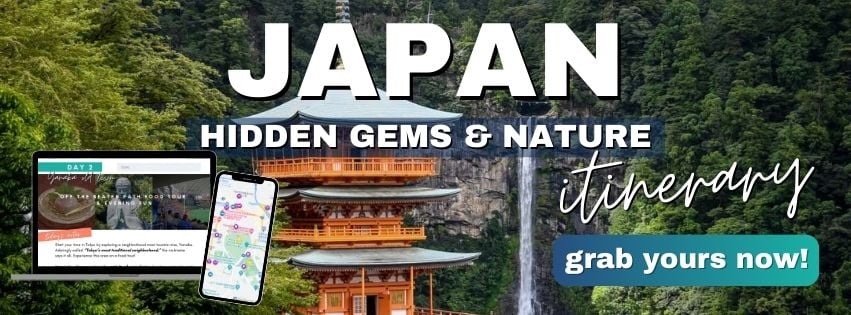
If you don’t have a ton of time to spend planning your Japan itinerary (or you just don’t find travel planning fun), we’ve got something you might be interested in…
We created the ultimate done-for-you Japan itinerary that is packed full of all sorts of tips we’ve gathered from 3 trips to Japan as well as literally hundreds of hours of research (no exaggeration).
We have both an off-the-beaten path route as well as a classic itinerary that hits the top attractions (perfect for your first visit to Japan!).
Don’t miss your chance to grab our Japan Pocket Guide!
This (totally FREE!) pocket guide is a condensed version of all the things you should know BEFORE & DURING your trip to Japan!
Just enter your email and we’ll immediately send our pocket guide straight to your inbox!
Save this article on Pinterest for later!

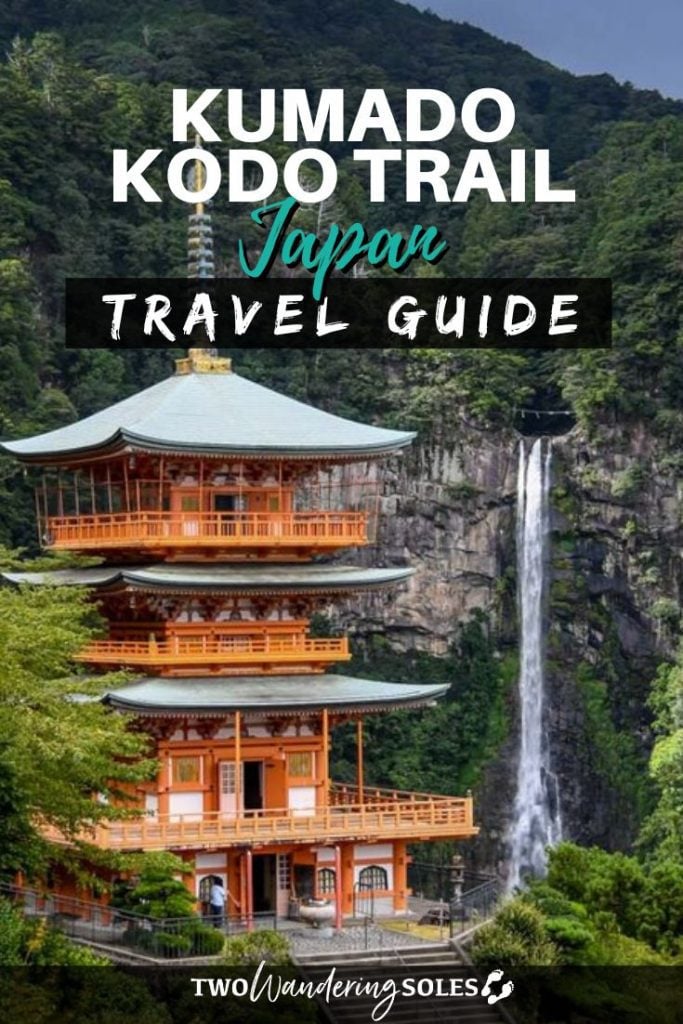
We want to hear from you!
Do you want to hike the Kumano Kodo Trail? When are you planning on going? Do you have any more questions about trekking on the Kumano Kodo? Let us know in the comments below!

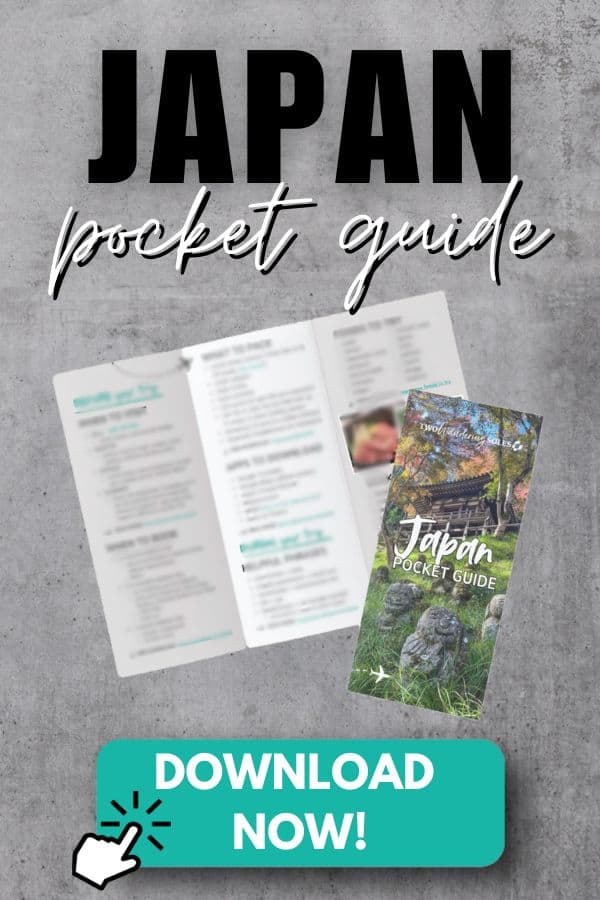
I’m on the way back to Osaka now having done 3 days on the trail more or less following your exact itinerary. This was such a useful resource, thank you!
You are so welcome, Jon! Hope you had a great hike!